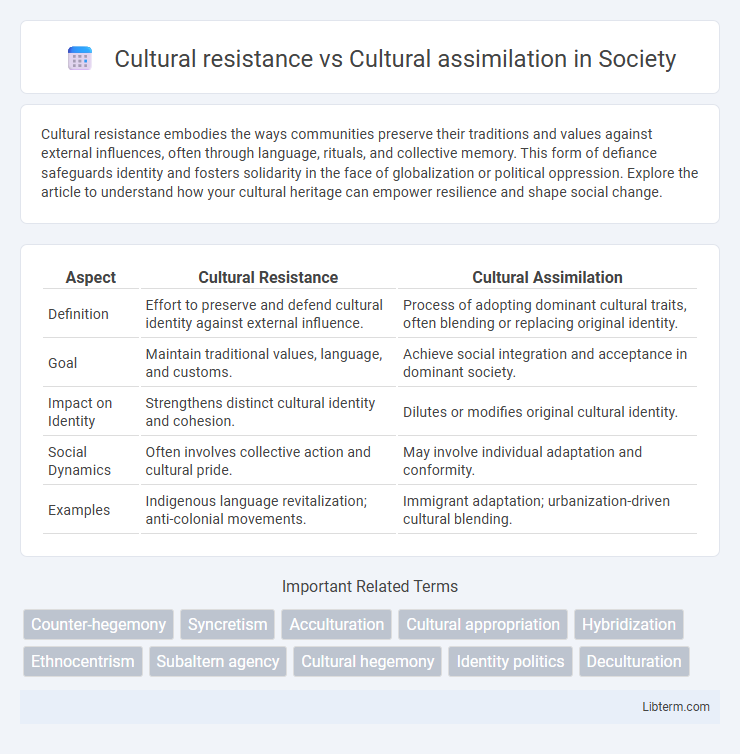Cultural resistance embodies the ways communities preserve their traditions and values against external influences, often through language, rituals, and collective memory. This form of defiance safeguards identity and fosters solidarity in the face of globalization or political oppression. Explore the article to understand how your cultural heritage can empower resilience and shape social change.
Table of Comparison
| Aspect | Cultural Resistance | Cultural Assimilation |
|---|---|---|
| Definition | Effort to preserve and defend cultural identity against external influence. | Process of adopting dominant cultural traits, often blending or replacing original identity. |
| Goal | Maintain traditional values, language, and customs. | Achieve social integration and acceptance in dominant society. |
| Impact on Identity | Strengthens distinct cultural identity and cohesion. | Dilutes or modifies original cultural identity. |
| Social Dynamics | Often involves collective action and cultural pride. | May involve individual adaptation and conformity. |
| Examples | Indigenous language revitalization; anti-colonial movements. | Immigrant adaptation; urbanization-driven cultural blending. |
Defining Cultural Resistance and Assimilation
Cultural resistance refers to the act of maintaining and asserting one's cultural identity, traditions, and practices in the face of dominant cultural pressures or influences. Cultural assimilation involves the process by which individuals or groups adopt the customs, values, and behaviors of another culture, often resulting in the loss of their original cultural identity. These contrasting concepts highlight the dynamics between preserving cultural uniqueness and integrating into a prevailing cultural framework.
Historical Contexts of Cultural Interaction
Cultural resistance involves marginalized or colonized groups maintaining traditional practices, languages, and beliefs to oppose assimilation pressures during historical periods such as colonialism or forced migration. Cultural assimilation occurs when dominant societies impose their values, often through policies like residential schools or language bans, aiming to absorb minority groups into the mainstream culture. Historical contexts of cultural interaction reveal power imbalances where resistance served as a tool for preserving identity, while assimilation efforts sought to erase cultural diversity.
Key Drivers of Cultural Resistance
Key drivers of cultural resistance include the desire to preserve identity, protect traditional values, and maintain social cohesion within a community. Factors such as historical oppression, perceived threats to language and customs, and strong attachment to ancestral heritage intensify resistance efforts. Economic disparities and political marginalization also fuel cultural resistance by reinforcing feelings of exclusion and the need for self-determination.
Factors Influencing Cultural Assimilation
Factors influencing cultural assimilation include socio-economic status, language proficiency, and social networks that facilitate integration into the dominant culture. Educational opportunities and government policies also play critical roles in shaping the pace and extent of cultural assimilation. Additionally, individual attitudes towards cultural identity and community support systems significantly impact how cultural resistance or assimilation manifests.
Examples of Resistance in Minority Communities
Minority communities exhibit cultural resistance through practices such as maintaining native languages, traditional rituals, and religious customs despite dominant societal pressures to assimilate. Examples include Native American tribes revitalizing Indigenous languages and ceremonies, and African American communities preserving spirituals and oral histories during periods of cultural suppression. These acts of resistance reinforce identity and foster resilience against cultural homogenization imposed by majority cultures.
The Role of Power Dynamics in Cultural Exchange
Power dynamics critically shape cultural resistance and cultural assimilation, influencing which cultural traits dominate or are marginalized in exchanges. Dominant groups often impose cultural norms through institutional control and social pressure, leading to assimilation, while marginalized communities employ resistance to maintain identity and autonomy. These interactions reflect broader struggles over authority, identity, and access to resources within the cultural landscape.
Identity and the Struggle for Preservation
Cultural resistance emphasizes the active effort of marginalized groups to maintain their unique identity, language, and traditions against dominant societal pressures. Cultural assimilation often leads to the erosion of original customs as individuals adopt the dominant culture's norms in pursuit of social acceptance. The struggle for preservation centers on safeguarding cultural heritage to sustain collective memory and affirm self-identity amid forces that promote homogenization.
Media’s Influence on Assimilation and Resistance
Media plays a critical role in shaping cultural assimilation by promoting dominant cultural narratives and norms, often encouraging minority groups to adopt mainstream values and practices. Conversely, alternative and independent media outlets serve as platforms for cultural resistance by amplifying marginalized voices and preserving indigenous traditions, languages, and identities. The interplay between mainstream media and counter-media influences the extent to which assimilation or resistance occurs within diverse societies.
Consequences of Assimilation for Cultural Heritage
Cultural assimilation often leads to the erosion of traditional practices, languages, and customs, resulting in the loss of unique cultural identities. This process can cause marginalized communities to experience a decline in cultural heritage transmission across generations, weakening social cohesion and communal bonds. The homogenization of cultures through assimilation diminishes diversity, impacting collective memory and reducing the richness of global cultural landscapes.
Paths Toward Cultural Harmony and Coexistence
Cultural resistance involves actively preserving distinct cultural identities and practices to counter homogenization, while cultural assimilation emphasizes integrating minority groups into dominant cultural norms. Paths toward cultural harmony and coexistence include embracing multiculturalism, fostering intercultural dialogue, and encouraging mutual respect among diverse communities. Policies promoting inclusive education and community participation play a crucial role in balancing preservation with integration for sustainable social cohesion.
Cultural resistance Infographic

 libterm.com
libterm.com